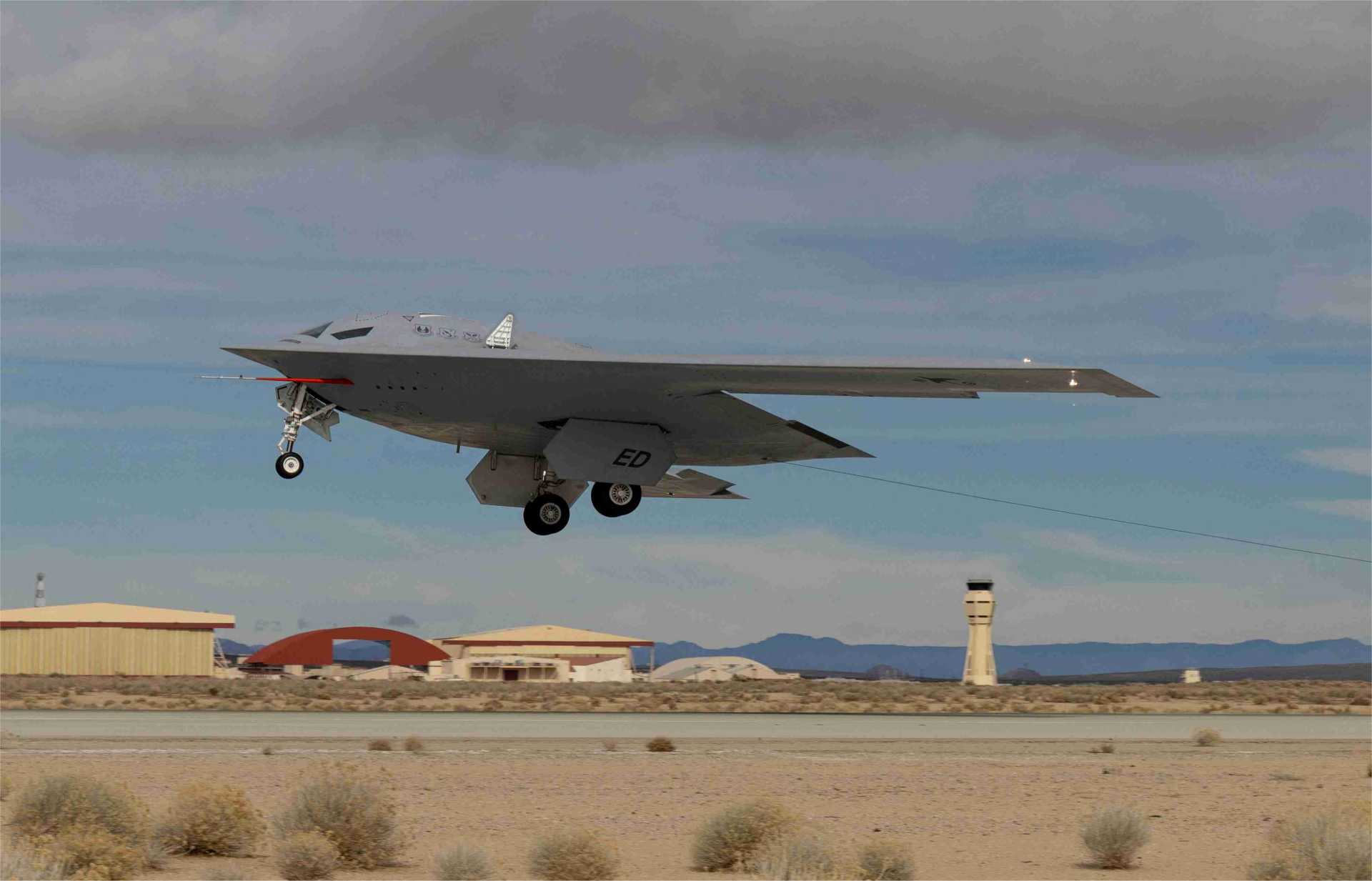Breaking News: U.S. Boosts New B-21 Raider Stealth Bomber Program with Additional $4.5 Billion Investment

{loadposition bannertop}
{loadposition sidebarpub}
On April 27, 2025, the United States Department of Defense announced a sweeping $150 billion supplemental defense budget package, with a significant $4.5 billion allocation specifically dedicated to accelerating the new U.S. Air Force B-21 Raider stealth bomber program. This funding underscores the critical role the B-21 plays in the future of American airpower and nuclear deterrence. As a highly advanced long-range stealth bomber, the B-21 Raider is designed to penetrate the most sophisticated enemy air defenses, deliver both conventional and nuclear payloads, and ensure the U.S. retains strategic superiority in an era marked by intensifying great-power competition.Follow Army Recognition on Google News at this link
A U.S. Air Force B-21 Raider undergoes flight testing at Edwards Air Force Base, California, United States. (Picture source: U.S. DoD)
The B-21 Raider traces its origins to the early 2010s, when the U.S. Air Force launched the Long Range Strike Bomber (LRS-B) program. This initiative emerged from growing concerns over the aging B-52H Stratofortress, B-1B Lancer, and B-2 Spirit fleets, many of which were increasingly expensive to maintain and ill-suited for high-end conflict environments. The LRS-B program aimed to develop a new generation of bombers with deep-strike capabilities, survivability in highly contested environments, and adaptability for future technological upgrades.
After a rigorous competition, the U.S. Air Force awarded the development contract in October 2015 to Northrop Grumman, defeating a rival team composed of Boeing and Lockheed Martin. The contract was structured with cost controls and performance incentives to avoid the delays and budget overruns that plagued earlier major procurement programs. Soon after, the aircraft was officially named the B-21 “Raider” to honor the Doolittle Raiders of World War II—a symbolic reference to bold long-range missions deep into enemy territory.
The B-21 design incorporates lessons learned from the B-2 Spirit, but with significant advancements. Its open systems architecture allows for easier integration of emerging technologies, while its stealth features include reduced radar and infrared signatures that surpass previous platforms. The aircraft is engineered to support both manned and unmanned missions, and is expected to integrate future capabilities such as directed energy weapons, autonomous flight, and enhanced electronic warfare systems. With the ability to carry both precision-guided conventional weapons and nuclear armaments, the B-21 ensures flexibility across the full spectrum of strategic deterrence.
Northrop Grumman began assembly of the first test articles at Air Force Plant 42 in Palmdale, California, where the B-21 was officially rolled out to the public in December 2022. The first flight took place on November 10, 2023, marking a major milestone in the program’s timeline. The aircraft departed Palmdale and flew to Edwards Air Force Base, where the Air Force’s 412th Test Wing began the rigorous flight testing campaign. These tests are validating the aircraft’s aerodynamic performance, radar cross-section, stealth signature, systems integration, and mission software. According to defense officials, the flight tests have met or exceeded initial expectations, though most details remain classified.
On April 4, 2024, the U.S. Department of Defense publicly confirmed that the B-21 Raider had officially entered a sustained phase of flight testing at Edwards Air Force Base. The aircraft was actively undergoing ground testing, taxiing, and flying operations as part of its comprehensive evaluation program. In a strategic statement, the Pentagon emphasized that the B-21 Raider will be able to interoperate with U.S. allies and partners to deliver flexible strike options in coalition operations. This is a crucial capability in today’s interconnected threat environment, where multinational cooperation and interoperability are key to deterring and, if necessary, defeating common adversaries.
In parallel with flight testing, ground-based evaluations have been conducted, including electromagnetic interference trials, climate survivability tests, and stealth integrity verification. Several additional B-21 aircraft are currently in various stages of assembly, and the program is progressing steadily toward low-rate initial production. The first operational B-21 units will be based at Ellsworth Air Force Base in South Dakota, which is already undergoing infrastructure upgrades to support the Raider fleet.
The Air Force plans to procure at least 100 B-21 bombers, though recent strategic assessments suggest this number may rise to between 145 and 200 to fully replace the existing bomber fleet and support the demands of simultaneous global operations. The aircraft’s global reach and deep-penetration strike ability make it an essential asset for future missions in both the Indo-Pacific and European theaters, where adversaries have developed sophisticated A2/AD networks.
This new $4.5 billion funding boost will support continued development, production scale-up, personnel training, and supply chain expansion. It is also expected to accelerate base construction and long-term sustainment planning, enabling a smoother transition into full operational capability by the end of the decade. Importantly, the program’s emphasis on digital engineering and lifecycle affordability positions the B-21 as a fiscally sustainable cornerstone of American airpower for decades to come.
The new U.S. B-21 Raider stealth bomber represents more than just a new aircraft—it is the future of American strategic deterrence and global power projection. Its development ensures that the United States remains prepared to meet the security challenges of the 21st century with unmatched reach, resilience, and technological superiority, while closely aligning with the capabilities and operational doctrines of allied forces around the world.

{loadposition bannertop}
{loadposition sidebarpub}
On April 27, 2025, the United States Department of Defense announced a sweeping $150 billion supplemental defense budget package, with a significant $4.5 billion allocation specifically dedicated to accelerating the new U.S. Air Force B-21 Raider stealth bomber program. This funding underscores the critical role the B-21 plays in the future of American airpower and nuclear deterrence. As a highly advanced long-range stealth bomber, the B-21 Raider is designed to penetrate the most sophisticated enemy air defenses, deliver both conventional and nuclear payloads, and ensure the U.S. retains strategic superiority in an era marked by intensifying great-power competition.
Follow Army Recognition on Google News at this link
A U.S. Air Force B-21 Raider undergoes flight testing at Edwards Air Force Base, California, United States. (Picture source: U.S. DoD)
The B-21 Raider traces its origins to the early 2010s, when the U.S. Air Force launched the Long Range Strike Bomber (LRS-B) program. This initiative emerged from growing concerns over the aging B-52H Stratofortress, B-1B Lancer, and B-2 Spirit fleets, many of which were increasingly expensive to maintain and ill-suited for high-end conflict environments. The LRS-B program aimed to develop a new generation of bombers with deep-strike capabilities, survivability in highly contested environments, and adaptability for future technological upgrades.
After a rigorous competition, the U.S. Air Force awarded the development contract in October 2015 to Northrop Grumman, defeating a rival team composed of Boeing and Lockheed Martin. The contract was structured with cost controls and performance incentives to avoid the delays and budget overruns that plagued earlier major procurement programs. Soon after, the aircraft was officially named the B-21 “Raider” to honor the Doolittle Raiders of World War II—a symbolic reference to bold long-range missions deep into enemy territory.
The B-21 design incorporates lessons learned from the B-2 Spirit, but with significant advancements. Its open systems architecture allows for easier integration of emerging technologies, while its stealth features include reduced radar and infrared signatures that surpass previous platforms. The aircraft is engineered to support both manned and unmanned missions, and is expected to integrate future capabilities such as directed energy weapons, autonomous flight, and enhanced electronic warfare systems. With the ability to carry both precision-guided conventional weapons and nuclear armaments, the B-21 ensures flexibility across the full spectrum of strategic deterrence.
Northrop Grumman began assembly of the first test articles at Air Force Plant 42 in Palmdale, California, where the B-21 was officially rolled out to the public in December 2022. The first flight took place on November 10, 2023, marking a major milestone in the program’s timeline. The aircraft departed Palmdale and flew to Edwards Air Force Base, where the Air Force’s 412th Test Wing began the rigorous flight testing campaign. These tests are validating the aircraft’s aerodynamic performance, radar cross-section, stealth signature, systems integration, and mission software. According to defense officials, the flight tests have met or exceeded initial expectations, though most details remain classified.
On April 4, 2024, the U.S. Department of Defense publicly confirmed that the B-21 Raider had officially entered a sustained phase of flight testing at Edwards Air Force Base. The aircraft was actively undergoing ground testing, taxiing, and flying operations as part of its comprehensive evaluation program. In a strategic statement, the Pentagon emphasized that the B-21 Raider will be able to interoperate with U.S. allies and partners to deliver flexible strike options in coalition operations. This is a crucial capability in today’s interconnected threat environment, where multinational cooperation and interoperability are key to deterring and, if necessary, defeating common adversaries.
In parallel with flight testing, ground-based evaluations have been conducted, including electromagnetic interference trials, climate survivability tests, and stealth integrity verification. Several additional B-21 aircraft are currently in various stages of assembly, and the program is progressing steadily toward low-rate initial production. The first operational B-21 units will be based at Ellsworth Air Force Base in South Dakota, which is already undergoing infrastructure upgrades to support the Raider fleet.
The Air Force plans to procure at least 100 B-21 bombers, though recent strategic assessments suggest this number may rise to between 145 and 200 to fully replace the existing bomber fleet and support the demands of simultaneous global operations. The aircraft’s global reach and deep-penetration strike ability make it an essential asset for future missions in both the Indo-Pacific and European theaters, where adversaries have developed sophisticated A2/AD networks.
This new $4.5 billion funding boost will support continued development, production scale-up, personnel training, and supply chain expansion. It is also expected to accelerate base construction and long-term sustainment planning, enabling a smoother transition into full operational capability by the end of the decade. Importantly, the program’s emphasis on digital engineering and lifecycle affordability positions the B-21 as a fiscally sustainable cornerstone of American airpower for decades to come.
The new U.S. B-21 Raider stealth bomber represents more than just a new aircraft—it is the future of American strategic deterrence and global power projection. Its development ensures that the United States remains prepared to meet the security challenges of the 21st century with unmatched reach, resilience, and technological superiority, while closely aligning with the capabilities and operational doctrines of allied forces around the world.





